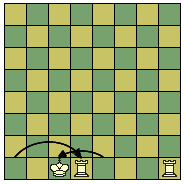Castling
|
|
|
Missing image |
| Kingside castling: O-O |
| Queenside castling: O-O-O |
Castling is a special move in the game of chess involving the king and either rook. Castling consists of moving the king two squares towards a rook, then moving the rook onto the square over which the king crossed. See the diagrams to the right.
Castling is a relatively recent European innovation in chess, dating from the 14 or 15th century. Thus, the Asian versions of chess do not have such a move.
Castling is only permissible if all of the following conditions hold:
- The player must never have moved the king;
- The player must never have moved the rook involved in castling;
- There must be no pieces between the king and the rook;
- The king must not be in check, the square the king crosses must not be attacked by an enemy piece, and the act of castling must not place the king in check. (The last part of this rule is part of the general rule of never placing one's king in check.)
It is a common mistake to think that the requirements for castling are even more stringent than the above. To clarify:
- The king may have been in check previously, as long as it isn't in check at the time of castling.
- The rook involved in castling may be under attack.
- The rook involved in castling may move over an attacked square. (This situation is only possible with queenside castling.)
The notation for castling is O-O on the kingside and O-O-O on the queenside, in both the descriptive and the algebraic systems. Kingside castling is generally slightly safer than queenside castling, because the castled king lands closer to the edge of the board and protects the rook pawn. It is common for both players to castle kingside, and quite rare for both players to castle queenside. If one player castles kingside and the other queenside, it is called opposite castling. Castling on opposite sides usually results in a fierce fight as the pawns on both sides are free to advance to attack the opposing king's castled position without exposing the player's own castled king. An example is the Dragon Variation of the Sicilian Defense.
Castling is an important goal in the early part of a game, because it serves two valuable purposes: it moves the king into a safer position away from the center of the board, and it moves the rook to a more active position in the center of the board. If the king is forced to move before it has the opportunity to castle, the player may still wish to maneuver the king towards the edge of the board and the corresponding rook towards the center. When a player takes three or four moves to accomplish what castling would have accomplished in one move, it is sometimes called artificial castling.
To signal the intention to castle, one should pick up the king first and move it two squares, and then move the rook over it. Under most tournament rules, if one picks up the rook first, one is obliged to move just that rook instead of castling.
Castling is in most non-English speaking nations known as 'Rochieren/Rochada', whilst 'queenside/kingside castling' is in those countries referred to as 'long/short' castling'.
Some chess variants have modified castling rules to handle modified starting positions. For an example, see the rules of Fischer Random Chess.
In chess problems, castling is assumed to be allowed if king and rook stand on their initial squares, unless it can be proved by retrograde analysis that one or both of them must have previously moved.de:Rochade el:Ροκέ es:Enroque it:Arrocco he:הצרחה hr:Rohada nl:Rokade pl:Roszada pt:Roque sl:Rokada (šah)

